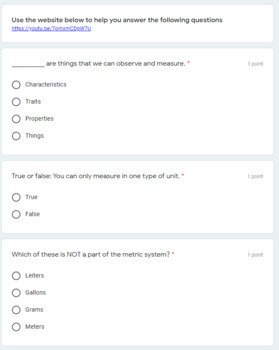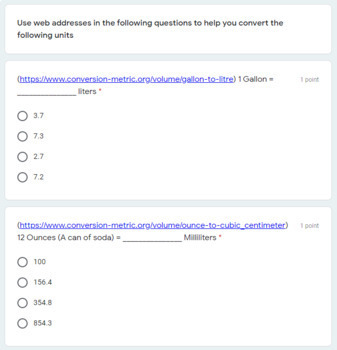Measuring Matter/Metric System WebQuest (MS-PS1) Great sub plans!
- Google Forms™
- Internet Activities
- Webquests

Also included in
- This collection of middle school science WebQuests covers a huge array of topics from physical, life and earth science topics. These webquests are ready to go at a moments notice, and include easy to read articles and short video clips to aid comprehensionPrice $82.25Original Price $117.50Save $35.25
- This bundle of three Web Quests (Google Forms) is based on the main ideas covered in Course 1, Topic 1 of the Pearson/Savvas science text and curriculum. I have used these WebQuests for years with great success. They are a great way to reinforce the main concepts of each lesson and as a bonus arePrice $6.00Original Price $7.00Save $1.00
Description
This WebQuest covers measurement and the metric system.
This WebQuest Includes:
- Short video clips (with built in links) to help introduce students to the concepts
- 20+ Self-Grading Multiple choice questions
- Online text that can easily be made into audio with online resources for students with accommodation concerns
What are people saying about Google Form resources from Huge House of Science?
"...So easy to use..."
“It was really organized and easy to use!”
"I had to get a sub unexpectedly and I gave them [the lesson] to do with my distance learning students and it went well. The sub said the lesson was easy to understand and execute and the students reported back that they liked the lesson."
"This was a great alternative for home-bound students with disabilities"
"...a quality, ready to go resource..."
"Students enjoyed it, and it was so easy to assign and use."
"This resource was exactly what I needed for days when I was absent from my online classroom!"
"I love that these resources help me to teach student in person AND those learning virtually."
"So amazing! Thank you for the simple way to introduce these topics!"
"My 8th graders were so excited..."
"This is perfect to use for sub plans or when you need to fill [time in] a class."







